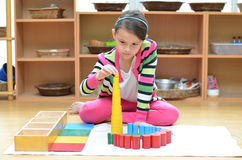Education is a natural process carried out by the human individual, and is acquired not by listening to words, but by experiences in the environment.” ~Maria Montessori
As young children begin exploring beyond the bounds of their own immediate surroundings, the Montessori Method — and the Seedling’s Montessori School — are prepared to help nurture their emerging curiosity, their sense of discovery, and their creativity. Our Primary classrooms, created for children ages 3 through 6, have been designed to foster the development of their linguistic, cognitive, and motor skills. They also help children ex plore the important roles they have to play within their family, their community, and their culture.
plore the important roles they have to play within their family, their community, and their culture.
We find the best way to describe our academic program for the multi-age groups is with an overview of the various elements that make up the Montessori experience. The environment is designed to facilitate maximum independent learning and exploration by the child. The core of the program includes learning aimed at Practical life, Sensorial Exercises, Language, Mathematics, History, Geography and Science. It is a calm and structured space designed to meet the needs of every child and match their scale of learning. With constant interaction with peers, the children learn to take responsibility for themselves and each other. The multi-age setting helps children to learn from each other and because of each other. They also learn to get along as a community by respecting peers of different ages and abilities.
🌟 1. Multi-Age Classrooms (Ages 3–6)
The Primary Program features mixed-age classrooms, allowing children to learn from and with each other. This setup fosters peer learning, mentorship, and a strong sense of community, as older students guide younger ones, and all children develop respect for varying abilities.
🌱 2. Holistic Montessori Curriculum with modern approach
The curriculum encompasses core areas such as Practical Life, Sensorial Exercises, Language, Mathematics, History, Geography, and Science. This comprehensive approach nurtures linguistic, cognitive, and motor skills, supporting the development of the whole child.
🧠 3. Emphasis on Independent Learning
Classrooms are thoughtfully designed to encourage maximum independent exploration. Children engage in self-directed activities, promoting autonomy, logical reasoning, and abstract thinking, all within a calm and structured environment.
🎨 4. Joyful and Cooperative Learning Environment
Learning is made joyful through a balance of individual and small group activities. This structure not only fosters academic growth but also emphasizes cooperation, helping children understand the importance of working together.
🎓 5. Pivotal Kindergarten Year
The Kindergarten year in the Montessori Early Childhood classroom is the most important! The third year, typically the Kindergarten year, is considered crucial. It consolidates earlier lessons into a permanent understanding. Kindergarteners take on leadership roles, serving as role models for younger peers, which enhances their confidence and reinforces their learning.
🎓6. Nurturing Emerging Growth
Reading, writing, math, and other cognitive skills are encouraged and developed in this program, as we introduce a number of activities designed to foster both logical reasoning and abstract thinking. However, while we begin to incorporate academic components into each child’s day — with sequential work in the arts, language, math, geography, and the sciences — we do so in such a way that makes learning a joyful experience. Children work both on their own and as parts of small groups, giving them the freedom to explore while teaching them the importance of cooperation.
